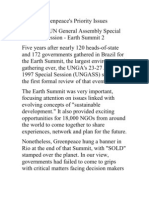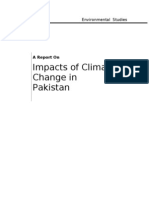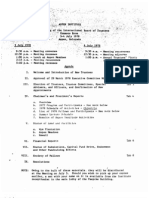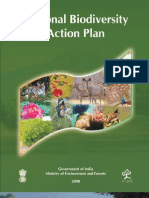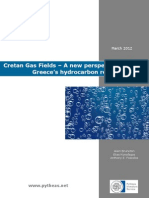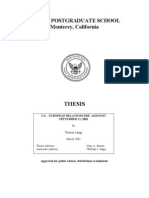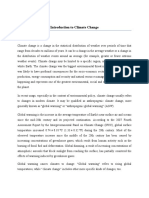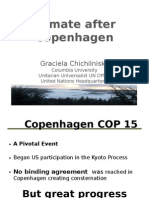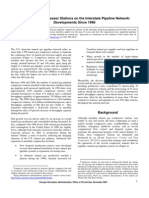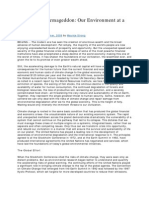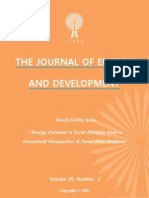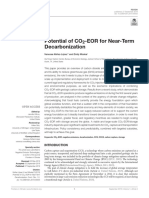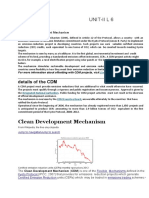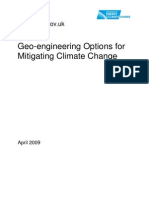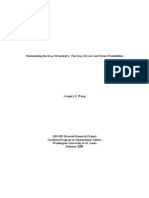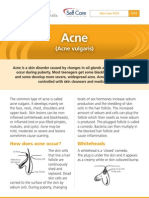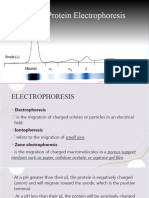Brief History of Environmental Diplomacy
Brief History of Environmental Diplomacy
Uploaded by
Aiko ShimizuCopyright:
Available Formats
Brief History of Environmental Diplomacy
Brief History of Environmental Diplomacy
Uploaded by
Aiko ShimizuOriginal Description:
Copyright
Available Formats
Share this document
Did you find this document useful?
Is this content inappropriate?
Copyright:
Available Formats
Brief History of Environmental Diplomacy
Brief History of Environmental Diplomacy
Uploaded by
Aiko ShimizuCopyright:
Available Formats
Brief History of Environmental Diplomacy Economic growth was at the forefront of international discussions before, but rising changes
in the global situation of the environment that may lead to wide scale resource depletion and endanger the worlds population warranted the urgent management of the incessant issue of environmental degradation. According to Sascha Mller Kraener during the Environmental Diplomacy conference in Washington D.C. in 1998 environmental diplomacy was first talked about after the end of Cold War, when everyone dreamed about shedding the peace dividend and addressing global change questions like the economic development of the South, population growth, the spread of democracy and human rights, and last but not the least, the looming environmental crisis (AICGS, 1999). The UNs first major conference that dealt with environmental crisis is the United Nations Conference on the Human Environment, also known as the Stockholm Conference, in 1972. It marked a turning point in the development of international environmental politics, more so for it led to the creation of the United Nations Environment Programme which is the voice of the environment within the UN system (unep.org). The second global environmental conference was the United Nations Conference on Environment and Development, also known as the Earth Summit, in Rio de Janeiro in 1992 which resulted in the creation of the Agenda 21 and the Commission on Sustainable Development (CSD). It is during this conference that environment and development policy were put at the top of the international agenda. But according to Mller Kraener, the spirit of Rio did not prevail. The framework of sustainable development during the Rio conference was overshadowed by another global trend which was the rising economies of the South particularly in the regions of Latin America and Asia and the economic crisis in Western Europe. This phenomenon was called globalization. In the words of Mller Kraener globalization has removed the global environmental crisis from the agenda of the worlds political leadership (AICGS, 1999). And although there was an increase in international environmental policies, the environmental crisis persisted and even worsened.
Key Instruments of Environmental Diplomacy The two major global conferences that propelled environmental crisis as a top agenda in the international political arena are which were previously discussed, the Stockholm conference of 1972, which created the UNEP, and the Earth summit in Rio in 1992 which resulted in Agenda 21 and the CSD. These can be considered as key instruments of environmental diplomacy. But aside from these, there has been a surge of conventions and efforts to address the new global environmental crisis once the issue has been laid out in the international political platform. These include the 1985 Vienna Convention on Protecting the Ozone Layer; the 1987 Montreal Protocol on Substances That Deplete the Ozone Layer; the 1989 Basel Convention on the Control of Transboundary Movements of Hazardous Wastes; the establishment in 1991 of the Global Environment Facility; the 1992 UN Framework Convention on Climate Change; the 1992 Convention on Biological Diversity; the 1994 UN Conference on Sustainable Development of Small Island Developing States; the 1994 UN Convention to Combat Desertification; the 1997 Kyoto Protocol on Climate Change and just recently the Rio + 20 in 2012. The Stockholm conference of 1972 was the first attempt at a global effort to address the environmental crisis and so the Stockholm Declaration adopted basic and broad environmental policy goals and objectives rather than detailed and definite positions. The principal purpose of the Stockholm Conference was to serve as a practical means to encourage, and to provide guidelines to protect and improve the human environment and to remedy and prevent its impairment (General Assembly resolution 2581 (XXVI)). And after the Stockholm conference, global awareness on the issue increased (Handl, legal.un.org, 2013). The United Nations Environment Programme was established in 1972 as a result of the Stockhom Conference. It acts as a catalyst, advocate, educator and facilitator to promote the wise use and sustainable development of the environment (unep.org, 2013). Its work encompasses the assessment of global, regional and national environmental conditions and trends, development of international and national environmental instruments and strengthening of institutions for the wise management of the environment (unep.org, 2013). In the 70s studies showed that the chemicals we produced could harm the ozone layer, which protects the earth from excessive ultraviolet radiation that may cause mutations in human,
plant and animal cells. Scientists found out that chloroflourocarbon gases (CFCs), could stay in the stratosphere for decades to centuries, and by releasing chlorine, break down the ozone layer (Weiss, legal.un.org, 2013). In 1981, UNEP drafted a global framework convention on stratospheric ozone protection and so in 1985 the Vienna Convention was held. It is a framework agreement in which States agree to cooperate in relevant research and scientific assessments of the ozone problem, to exchange information, and to adopt appropriate measures to prevent activities that harm the ozone layer (Weiss, legal.un.org, 2013). The 1987 Montreal Protocol on Substances That Deplete the Ozone Layer was created to reduce the production and consumption of substances that could be detrimental to the ozone layer. It enables the Parties to the Protocol to agree to accelerate the reductions required on the substances mentioned in the Protocol (UNEP Ozone Secretariat, 2011). 1989 Basel Convention on the Control of Transboundary Movements of Hazardous Wastes, also known as the Basel Convention, is a response to the discovery of deposits of toxic wastes in Africa and other parts of the developing world during the 1980s. The Global Environment Facility which was established in 1991 unites 183 countries in partnership with international institutions, civil society organizations, and the private sector to address environmental issues and promote sustainable development efforts. The GEF provides grants for projects and programs dedicated to biodiversity, climate change, international waters, land degradation, the ozone layer and persistent organic pollutants (GEF, 2013). The United Nations Conference on Environment and Development, also known as the Earth Summit, in Rio de Janeiro in 1992 is a two week event that led to the adoption of Agenda 21, a wide ranging blueprint for action to achieve sustainable development worldwide. It is a comprehensive programme of global action in all areas of sustainable development. The Earth Summit also resulted in two other conventions the UN Framework Convention on Climate Change and the Convention on Biological Diversity (un.org, 1997). The environmental crisis is affecting all of us, but more so the Small Islands of Developing country and so in 1994 the UN Conference on Sustainable Development of Small Island Developing States was held.
International consensus was reached regarding the creation of a legally - binding convention on climate change. In 1990, at the Second World Climate Conference in Geneva, it became apparent that there is a North/South divide because of conflicting interests and issues, but despite this in 1992 during the Earth Summit various States became a party to the UN Framework Convention on Climate Change. The long-term objective of the Convention and its related legal instruments is to achieve [] the stabilization of greenhouse gas concentrations in the atmosphere at a level that would prevent dangerous anthropogenic interference with the climate system (article 2). Climate change is defined by the Convention as change of climate which is attributed directly or indirectly to human activity that alters the composition of the global atmosphere and which is in addition to natural climate variability observed over comparable time periods (article 1 (2)) (de Chazournes, legal.un.org, 2013). The Earths natural resources are the fuel for our economic and social development, but constant consumption without leaving room for regeneration and recuperation of the environment posed a threat to all species on Earth. In response to this UNEP decided that there should be an international instrument to address this issue, thus the 1992 Convention on Biological Diversity was made (Convention on Biological Diversity, n.d.). Along with the two conventions and Agenda 21, the Commission on Sustainable Development was also made as a result of the Earth Summit. It was established by the UN General Assembly in 1992 to ensure the continuous and effective follow up of the Earth Summit. It framework of action is highly participatory by engaging with a wide set of official stakeholders and partners (UN Sustainable Development Knowledge Platform, n.d.). The 1994 UN Convention to Combat Desertification is the sole legally-binding international treaty linking environment and development to sustainable land management. The convention specifically addresses the problems in the dry lands, where there are a lot of vulnerable people and ecosystems. The convention aims to better the living conditions of the people in these dry lands, improve their soil productivity and to prevent drought (UNCCD, 2012).
The 1997 Kyoto Protocol on Climate Change is an international agreement related to the UN Framework Convention on Climate Change, which binds its parties to following international emission targets, and provided creative mechanisms to help these countries achieve the emission targets (UNFCC, 2014). And lastly the very recent Rio + 20 or the UN Conference on Sustainable Development which took place in Rio de Janeiro in Brazil last 2012 was the biggest UN Conference ever and a major step forward in achieving sustainable development. World leaders along with the private sector, NGOs and other groups discussed how to reduce poverty, advance social equity and ensure environmental protection (un.org, 2013). Sources: American Institute for Contemporary German Studies. (1999). Environmental Diplomacy: Conference Report. AICGS. NW, Washington D.C. UNEP. (n.d.) ABOUT UNEP: The voice of the Environment. Retrieved January 10, 2014 from: http://www.unep.org/About/ Handl, G. (2013). Declaration of the United Nations Conference on the Human Environment and Rio Declaration on Environment and Development. Retrieved January 10, 2014 from: http://legal.un.org/avl/ha/dunche/dunche.html Weiss, E.B. (2013). Vienna Convention for the Protection of the Ozone Layer and Montreal Protocol on Substances that Deplete the Ozone Layer. Retrieved January 10, 2014 from: http://legal.un.org/avl/ha/vcpol/vcpol.html UNEP Ozone Secretariat. (2011). The Montreal Protocol on Substances that Deplete the Ozone Layer. Retrieved January 10, 2014 from: http://ozone.unep.org/new_site/en/montreal_protocol.php GEF.ORG (2013). What is the GEF. Retrieved January 10, 2014 from: http://www.thegef.org/gef/whatisgef UN (1997). Earth Summit. Retrieved January 10, 2014 from: http://www.un.org/geninfo/bp/envirp3.html de Chazournes, L.B. (2013). United Nations Framework Convention on Climate Change. Retrieved January 10, 2014 from: http://legal.un.org/avl/ha/ccc/ccc.html Convention on Biological Diversity. (n.d.). History of the Convention. Retrieved January 10, 2014 from: http://www.cbd.int/history/
UN Sustainable Development Knowledge Platform (n.d.). Commission on Sustainable Development (CSD). Retrieved January 10, 2014 from: http://sustainabledevelopment.un.org/csd.html UNCCD. (2012). About the Convention. Retrieved January 10, 2014 from: http://www.unccd.int/en/about-the-convention/Pages/About-the-Convention.aspx UN. (2013). UNFCCC and Kyoto Protocol. Retrieved January 10, 2014 from: http://www.un.org/wcm/content/site/climatechange/pages/gateway/the-negotiations/the-unclimate-change-convention-and-the-kyoto-protocol UN. (2013). Rio + 20. Retrieved January 10, 2014 from: http://www.un.org/en/sustainablefuture/about.shtml
You might also like
- Fertilization and Irrigation Table of ContentsDocument5 pagesFertilization and Irrigation Table of ContentsNelsonSeries seriesNo ratings yet
- The Green Qualifications Workbook - Chapter 1Document13 pagesThe Green Qualifications Workbook - Chapter 1Akshya kumatNo ratings yet
- Earth Summit 1997Document27 pagesEarth Summit 1997Mihir GandhiNo ratings yet
- False NecessityDocument3 pagesFalse NecessitynieotyagiNo ratings yet
- Isobutane Butane Fractionator PDFDocument7 pagesIsobutane Butane Fractionator PDFhoustonmathNo ratings yet
- Centaflex CouplingDocument34 pagesCentaflex CouplingosaniamecNo ratings yet
- Biasi ManualDocument44 pagesBiasi Manuallimu_lNo ratings yet
- Eastern Mediterranean Geopolitical Review 2015Document75 pagesEastern Mediterranean Geopolitical Review 2015ncharalaNo ratings yet
- Impacts of Climate Change in Pakistan: A Report OnDocument19 pagesImpacts of Climate Change in Pakistan: A Report Onalammuneeb100% (2)
- Country Analysis Brief: Russia: Last Updated: October 31, 2017Document32 pagesCountry Analysis Brief: Russia: Last Updated: October 31, 2017Anonymous HJZffHvTNo ratings yet
- Aspen Institute Annual Meeting 1978 6pgs GOV EDUDocument6 pagesAspen Institute Annual Meeting 1978 6pgs GOV EDUWeirpNo ratings yet
- International Conventions 2019Document37 pagesInternational Conventions 2019Dhairya MahajanNo ratings yet
- In Economics and Political ScienceDocument409 pagesIn Economics and Political SciencechandusgNo ratings yet
- Study of Dry Ice Formation During Blowdown of CO - CH From CryogenicDocument9 pagesStudy of Dry Ice Formation During Blowdown of CO - CH From CryogenicAbul HassanNo ratings yet
- Biodiversity Action Plan 2008Document78 pagesBiodiversity Action Plan 2008faridkhanNo ratings yet
- Dismantling The Oil Wars MythDocument32 pagesDismantling The Oil Wars MythUmberto Tabalappi100% (1)
- Perspectives in Arctic SecurityDocument47 pagesPerspectives in Arctic SecurityLeo WiltshireNo ratings yet
- Assignment 1: Global Outlook of Biomass Energy in Current and Future 1.1Document12 pagesAssignment 1: Global Outlook of Biomass Energy in Current and Future 1.1Abishak Bahamut PrabuNo ratings yet
- Cretan Gas Fields - A New Perspective For Greeces Hydrocarbon ResourcesDocument24 pagesCretan Gas Fields - A New Perspective For Greeces Hydrocarbon ResourcesdanlbuNo ratings yet
- Russia, China, and The Energy-Security Politics of The Caspian Sea Region After The Cold WarDocument25 pagesRussia, China, and The Energy-Security Politics of The Caspian Sea Region After The Cold WarBárbara FernandesNo ratings yet
- Economic and Political Weekly Vol. 47, No. 12, MARCH 24, 2012Document84 pagesEconomic and Political Weekly Vol. 47, No. 12, MARCH 24, 2012RegNo ratings yet
- House Report On Big Oil LobbyingDocument8 pagesHouse Report On Big Oil LobbyingDaily KosNo ratings yet
- Carbon CreditsDocument3 pagesCarbon CreditsrockyrrNo ratings yet
- Impacts of GlobalisationDocument6 pagesImpacts of GlobalisationrupjitbNo ratings yet
- 9.global Environmental ConcernsDocument20 pages9.global Environmental ConcernsPrudhvi RajNo ratings yet
- Arms Control and Nonproliferation: A Catalog of Treaties and AgreementsDocument73 pagesArms Control and Nonproliferation: A Catalog of Treaties and AgreementssajidaNo ratings yet
- ICC, Climate Change, and Business at COP23Document3 pagesICC, Climate Change, and Business at COP23Jan DashNo ratings yet
- U.S. - European Relations Pre - and Post September 11, 2001Document137 pagesU.S. - European Relations Pre - and Post September 11, 2001Sebastian DojanaNo ratings yet
- Ecos 2012 PDFDocument512 pagesEcos 2012 PDFCarolina MedinaNo ratings yet
- A Carbon PricingDocument8 pagesA Carbon PricingSaba Imran MirNo ratings yet
- Raport CEPADocument96 pagesRaport CEPAlianaNo ratings yet
- Climate Change in PAKISTANDocument7 pagesClimate Change in PAKISTANhmalik87No ratings yet
- Koodankulam Anti-Nuclear Movement: A Struggle For Alternative Development?Document17 pagesKoodankulam Anti-Nuclear Movement: A Struggle For Alternative Development?Rajiv PonniahNo ratings yet
- Alaska Support Industry Alliance: October 27, 2011 Anchorage, AKDocument28 pagesAlaska Support Industry Alliance: October 27, 2011 Anchorage, AKVăn Đại - BKHNNo ratings yet
- House Hearing, 109TH Congress - The Vast North American Resource Potential of Oil Shale, Oil Sands, and Heavy Oils, Parts 1 and 2Document127 pagesHouse Hearing, 109TH Congress - The Vast North American Resource Potential of Oil Shale, Oil Sands, and Heavy Oils, Parts 1 and 2Scribd Government DocsNo ratings yet
- Earth SummitDocument3 pagesEarth SummitRa Pa0% (1)
- Chichilnisky UU UNO April 8 2010Document20 pagesChichilnisky UU UNO April 8 2010Jan DashNo ratings yet
- ASP Annual Report 2013Document19 pagesASP Annual Report 2013The American Security ProjectNo ratings yet
- Environmental Law AssignmentDocument18 pagesEnvironmental Law AssignmentbboydextorNo ratings yet
- Memorandum The White House: .cLASSDocument7 pagesMemorandum The White House: .cLASSIris van BurenNo ratings yet
- Climate Change and ConflictDocument5 pagesClimate Change and ConflictRicardo AmadorNo ratings yet
- Analysis of Alaska's Oil and Gas IndustryDocument20 pagesAnalysis of Alaska's Oil and Gas IndustryEricDarbyshire100% (1)
- LNG: Lessons From Down UnderDocument4 pagesLNG: Lessons From Down UndervimyridgeNo ratings yet
- Genocide As Crime LemkinDocument8 pagesGenocide As Crime LemkinRaphael T. SprengerNo ratings yet
- NG. Compressor StationDocument12 pagesNG. Compressor StationBrian MayNo ratings yet
- Facing Down Armageddon: Our Environment at A CrossroadsDocument8 pagesFacing Down Armageddon: Our Environment at A CrossroadsQuibus_LicetNo ratings yet
- Biogas - Opportunities For Farming, Industry and Environment PDFDocument89 pagesBiogas - Opportunities For Farming, Industry and Environment PDFNET ZERO SUMMITSNo ratings yet
- "Energy Demand in Rural Ethiopia From A Household Perspective: A Panel Data Analysis," by Dawit Diriba GutaDocument20 pages"Energy Demand in Rural Ethiopia From A Household Perspective: A Panel Data Analysis," by Dawit Diriba GutaThe International Research Center for Energy and Economic Development (ICEED)100% (1)
- Potential of CO2-EOR For Near-Term DecarbonizationDocument14 pagesPotential of CO2-EOR For Near-Term DecarbonizationJR RomanNo ratings yet
- Re: Comments of NY Renews To Case 15-E-0302, Environmental Impact Statement For The Climate Leadership and Community Protection ActDocument39 pagesRe: Comments of NY Renews To Case 15-E-0302, Environmental Impact Statement For The Climate Leadership and Community Protection ActGrey MoranNo ratings yet
- Energy Lecture PDF Combined PDFDocument177 pagesEnergy Lecture PDF Combined PDFjai hindNo ratings yet
- Global Warming Essay OutlineDocument4 pagesGlobal Warming Essay OutlineParvez Raees100% (1)
- Effects of Climate Change in PakistanDocument15 pagesEffects of Climate Change in PakistanDanish Obaid100% (1)
- Geo-Engineering-0409 Options For Mitigating Climate ChangeDocument27 pagesGeo-Engineering-0409 Options For Mitigating Climate ChangeMartin Wac HandNo ratings yet
- Who Influences American Foreign PolicyDocument17 pagesWho Influences American Foreign PolicyBert M DronaNo ratings yet
- The History of Environmental Policy and Pollution of Water Sources in NigeriaDocument16 pagesThe History of Environmental Policy and Pollution of Water Sources in Nigeriaawulu1No ratings yet
- US Energy Security: How We Got Here and Where We Are HeadedDocument28 pagesUS Energy Security: How We Got Here and Where We Are HeadedHoover InstitutionNo ratings yet
- Modernizing The Iraq Oil Industry: The Iraq Oil Law and Future PossibilitiesDocument26 pagesModernizing The Iraq Oil Industry: The Iraq Oil Law and Future Possibilitiesvgamenut100% (1)
- Peaceful Coexistence NeutralityDocument22 pagesPeaceful Coexistence NeutralityAna PostolacheNo ratings yet
- Subjectivism and Interpretative Methodology in Theory and PracticeFrom EverandSubjectivism and Interpretative Methodology in Theory and PracticeNo ratings yet
- Forest Product Conversion FactorsFrom EverandForest Product Conversion FactorsNo ratings yet
- International Environmental LawDocument4 pagesInternational Environmental LawShubhankar ThakurNo ratings yet
- Biological Molecules Assignment Worksheet: Due Date: 20/06/21Document11 pagesBiological Molecules Assignment Worksheet: Due Date: 20/06/21JS ManishNo ratings yet
- Plasblak LL3608: Name of Library Here Datasheet Number Black Masterbatches Plasblak LL3608Document2 pagesPlasblak LL3608: Name of Library Here Datasheet Number Black Masterbatches Plasblak LL3608SiddharthBhasneyNo ratings yet
- (Acne Vulgaris) : How Does Acne Occur? WhiteheadsDocument4 pages(Acne Vulgaris) : How Does Acne Occur? WhiteheadsMichael LuoNo ratings yet
- QUALITATIVE ANALYSIS OF COCONUT WATER - Investigatory ProjectDocument20 pagesQUALITATIVE ANALYSIS OF COCONUT WATER - Investigatory Projectadityagm.workNo ratings yet
- Aqa 2420 W TRB Psa02Document4 pagesAqa 2420 W TRB Psa02KelumNo ratings yet
- CoalDocument41 pagesCoalKarthi KeyanNo ratings yet
- 10.1007@s43450 020 00090 WDocument15 pages10.1007@s43450 020 00090 WauriNo ratings yet
- Drying Processes and MethodDocument21 pagesDrying Processes and Methodmirobel455kezaNo ratings yet
- ManualDocument13 pagesManualkick24502No ratings yet
- Fan Zhang, Paul A. Thibault and Rick Link - Shock Interaction With Solid Particles in Condensed Matter and Related Momentum TransferDocument23 pagesFan Zhang, Paul A. Thibault and Rick Link - Shock Interaction With Solid Particles in Condensed Matter and Related Momentum TransferGhoree23456No ratings yet
- Technical Data Sheet: Euro Antibak NbsDocument2 pagesTechnical Data Sheet: Euro Antibak Nbsxuân ba caoNo ratings yet
- 02 110 BPS Foam Pump Skid With Foam Pump and RC ControllerDocument8 pages02 110 BPS Foam Pump Skid With Foam Pump and RC Controllerarachman297988No ratings yet
- CHE 156a REDOX ReactionsDocument62 pagesCHE 156a REDOX ReactionsJosephNo ratings yet
- 2545-Article Text-7661-1-10-20190414 PDFDocument6 pages2545-Article Text-7661-1-10-20190414 PDFClariza ZulyanNo ratings yet
- Process Euipment Design and Drawing I_Heat ExchangerDocument64 pagesProcess Euipment Design and Drawing I_Heat Exchangervidhigupta115No ratings yet
- Separating Hydrogen and Oxygen Evolution in Alkaline Water Electrolysis Using Nickel HydroxideDocument8 pagesSeparating Hydrogen and Oxygen Evolution in Alkaline Water Electrolysis Using Nickel HydroxideAtzhiri VenturaNo ratings yet
- Tds Disperbyk-2205 enDocument6 pagesTds Disperbyk-2205 enSaurabh GujarNo ratings yet
- Assab 88-150216Document12 pagesAssab 88-150216jebripahlaviNo ratings yet
- All-Ceramic: A Review ofDocument11 pagesAll-Ceramic: A Review ofJoyce Natali FernándezNo ratings yet
- Experiment Acid and BaseDocument5 pagesExperiment Acid and BaseRebeca Valentina Caballero Alvarado100% (1)
- Reducing Major Defects in Radiators Manufacturing: Kumar P., Sonawane B.S., Sontakke R.R., Surves.B., Wasnik A.RDocument5 pagesReducing Major Defects in Radiators Manufacturing: Kumar P., Sonawane B.S., Sontakke R.R., Surves.B., Wasnik A.RKrushnaNo ratings yet
- 13.2 Biology LessonDocument31 pages13.2 Biology LessontimoNo ratings yet
- 5.lecture 1 - 5 - Cold N Hot Water in BuildingsDocument94 pages5.lecture 1 - 5 - Cold N Hot Water in Buildingsdany rwagatareNo ratings yet
- AcrylicTexturedPaint PDFDocument2 pagesAcrylicTexturedPaint PDFJude P. DenedoNo ratings yet
- Lc4 Stoich p1 Ay22-23Document6 pagesLc4 Stoich p1 Ay22-23Nikki nishimuraNo ratings yet
- Serum Protein ElectrophoresisDocument59 pagesSerum Protein ElectrophoresisLeo NoquilNo ratings yet
- Providing High-Quality Zinc Coatings (Hot-Dip) : Standard Practice ForDocument9 pagesProviding High-Quality Zinc Coatings (Hot-Dip) : Standard Practice ForAnderson TadeuNo ratings yet


